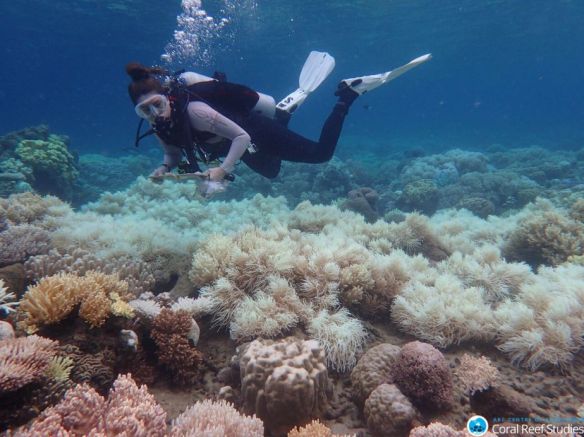In 2016, there was an obituary written for the Great Barrier Reef. The cause of death: climate change and ocean acidification. It died at the age of 25 million.
Australian scientists confirmed this is not far from the truth — if drastic action to save the reef is not taken. In a media release by the James Cook University, scientists conducted a survey last year in which they recorded severe coral bleaching across huge tracts of the Reef. They completed aerial surveys along its entire length. Reports said that while bleaching was most severe in the northern third of the Reef, the middle third has experienced the most intense coral bleaching.

Orpheus Island bleaching. Image: Greg Torda
Prof. Terry Hughes, Director of the ARC Centre of Excellence for Coral Reef Studies, who undertook the aerial surveys in both 2016 and 2017, said the combined impact of this back-to-back bleaching stretches for 1,500 km (900 miles), leaving only the southern third unscathed.
The bleaching is caused by record-breaking temperatures — even without the effects of El Niño conditions.
The aerial surveys in 2017 covered more than 8,000 km (5,000 miles) and scored nearly 800 individual coral reefs closely matching the aerial surveys in 2016 that were carried out by the same two observers.
Dr. James Kerry, who also undertook the aerial surveys, explains further, “this is the fourth time the Great Barrier Reef has bleached severely – in 1998, 2002, 2016, and now in 2017. Bleached corals are not necessarily dead corals, but in the severe central region we anticipate high levels of coral loss.”
It takes at least a decade for a full recovery of even the fastest growing corals, so mass bleaching events 12 months apart offers zero prospect of recovery for reefs that were damaged in 2016.”
Coupled with the 2017 mass bleaching event, Tropical Cyclone Debbie struck a corridor of the Great Barrier Reef at the end of March. The intense, slow-moving system was likely to have caused varying levels of damage along a path up to 100 km in width. Any cooling effects related to the cyclone are likely to be negligible in relation to the damage it caused, which unfortunately struck a section of the reef that had largely escaped the worst of the bleaching.
“Clearly the reef is struggling with multiple impacts,” explains Prof. Hughes. “Without a doubt the most pressing of these is global warming. As temperatures continue to rise the corals will experience more and more of these events: 1°C of warming so far has already caused four events in the past 19 years.”
‘Ultimately, we need to cut carbon emissions, and the window to do so is rapidly closing.”
Mining and Fossil Fuels
The Australian Conservation Foundation (ACF) blasts the mining and fossil fuels industry as well as the lack of government action. Mining and burning of fossil fuels– like coal – are warming the oceans and killing the reef, the Foundation claims.
Kelly O’Shanassy, ACF director said this is a global tragedy blaming the Australian government and coal companies for undermining action on global warming.
O’Shanassy said in order to have any chance of saving the rest of the reef, there should be a stop in digging up and burning coal and take the alternative — to rapidly repower Australia with clean energy.
“We are heartbroken, and furious. But we will not stop speaking out, showing up and holding people accountable for their decisions,” she said adding:
“The death of so much of our reef was not an accident. It was conscious choice. The government and coal companies knew this was coming yet for years they chose to undermine action on global warming. They laughed as they threw coal around Parliament.”
Follow @rdelarosayoon

You must be logged in to post a comment.